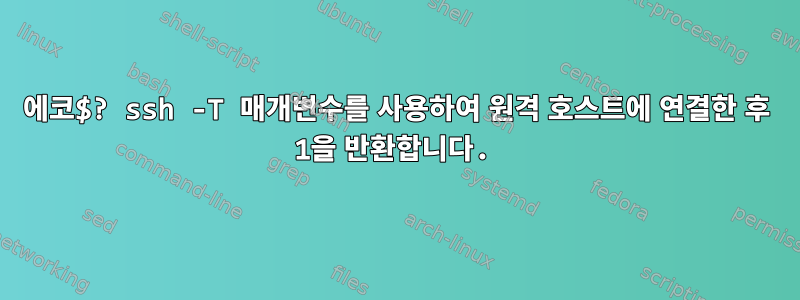
ssh -T foo@bar원격 호스트에 로그인 하는 데 사용합니다 . 그러나 echo $?명령은 로그인 성공 후에 응답합니다. 또한, 사용하시면 반품 부탁드립니다. 1echo $?0ssh -t foo@bar
코드는 을 1의미합니다 Catchall for general errors.
- 그렇다면 이 단계에서는 어떤 방법이 있을까요?
- 어떻게 고치나요?
감사해요
업데이트 #1
몇 가지 설명: 1. 질문:
로그인 후 서버에서 실행됩니까, 아니면 로그아웃 후 클라이언트에서 실행됩니까? A: 서버에 로그인 후 실행하고, 원격 서버에서 실행합니다. 2. 질문: 비활성화된 TTY 배포를 사용하는 경우 어떻게 로그인합니까? A: 작동합니다. 많은 컴퓨터에서 테스트했습니다. 3. 질문: 쉘 세션이 필요하지 않습니까? A: 아니요, 그냥 사용하고 싶지 않아요. 이것은 또한 SSH 세션입니다. 내 프로그램에서 "깨끗한" 메시지를 사용해야 합니다. 이것은 대화형 환경이 아닙니다. echo $?echo $?-Tpseudo-terminal
다시 한 번 감사드립니다!
업데이트 #2
일부 환경 파일.
1.~/.profile 파일
if [ "$BASH" ]; then
if [ -f ~/.bashrc ]; then
. ~/.bashrc
fi
fi
tty -s && mesg n
~/.bashrc 파일:
# ~/.bashrc: executed by bash(1) for non-login shells. # see /usr/share/doc/bash/examples/startup-files (in the package bash-doc) # for examples # If not running interactively, don't do anything [ -z "$PS1" ] && return # don't put duplicate lines in the history. See bash(1) for more options # ... or force ignoredups and ignorespace HISTCONTROL=ignoredups:ignorespace # append to the history file, don't overwrite it shopt -s histappend # for setting history length see HISTSIZE and HISTFILESIZE in bash(1) HISTSIZE=1000 HISTFILESIZE=2000 # check the window size after each command and, if necessary, # update the values of LINES and COLUMNS. shopt -s checkwinsize # make less more friendly for non-text input files, see lesspipe(1) [ -x /usr/bin/lesspipe ] && eval "$(SHELL=/bin/sh lesspipe)" # set variable identifying the chroot you work in (used in the prompt below) if [ -z "$debian_chroot" ] && [ -r /etc/debian_chroot ]; then debian_chroot=$(cat /etc/debian_chroot) fi # set a fancy prompt (non-color, unless we know we "want" color) case "$TERM" in xterm-color) color_prompt=yes;; esac # uncomment for a colored prompt, if the terminal has the capability; turned # off by default to not distract the user: the focus in a terminal window # should be on the output of commands, not on the prompt #force_color_prompt=yes if [ -n "$force_color_prompt" ]; then if [ -x /usr/bin/tput ] && tput setaf 1 >&/dev/null; then # We have color support; assume it's compliant with Ecma-48 # (ISO/IEC-6429). (Lack of such support is extremely rare, and such # a case would tend to support setf rather than setaf.) color_prompt=yes else color_prompt= fi fi if [ "$color_prompt" = yes ]; then PS1='${debian_chroot:+($debian_chroot)}\[\033[01;32m\]\u@\h\[\033[00m\]:\[\033[01;34m\]\w\[\033[00m\]\$ ' else PS1='${debian_chroot:+($debian_chroot)}\u@\h:\w\$ ' fi unset color_prompt force_color_prompt # If this is an xterm set the title to user@host:dir case "$TERM" in xterm*|rxvt*) PS1="\[\e]0;${debian_chroot:+($debian_chroot)}\u@\h: \w\a\]$PS1" ;; *) ;; esac # enable color support of ls and also add handy aliases if [ -x /usr/bin/dircolors ]; then test -r ~/.dircolors && eval "$(dircolors -b ~/.dircolors)" || eval "$(dircolors -b)" alias ls='ls --color=auto' #alias dir='dir --color=auto' #alias vdir='vdir --color=auto' alias grep='grep --color=auto' alias fgrep='fgrep --color=auto' alias egrep='egrep --color=auto' fi # some more ls aliases alias ll='ls -alF' alias la='ls -A' alias l='ls -CF' # Alias definitions. # You may want to put all your additions into a separate file like # ~/.bash_aliases, instead of adding them here directly. # See /usr/share/doc/bash-doc/examples in the bash-doc package. if [ -f ~/.bash_aliases ]; then . ~/.bash_aliases fi # enable programmable completion features (you don't need to enable # this, if it's already enabled in /etc/bash.bashrc and /etc/profile # sources /etc/bash.bashrc). #if [ -f /etc/bash_completion ] && ! shopt -oq posix; then # . /etc/bash_completion #fi
답변1
tty -s파일 에서 사용 중이고 .profile로그인 쉘을 사용할 때 TTY가 없으므로 ssh -T명령이 실패하고 $?1로 설정됩니다.
이는 예상되는 전체 명령입니다.
tty -s && mesg n
이에 의존하므로 TTY가 없으면 실행되지 않습니다( mesg n요즘에는 거의 사용되지 않는 "다른 사용자의 메시지 억제"를 통해).talkwrite
이 문제를 "수정"하려면 해당 행을 주석 처리하거나 제거하면 됩니다 .profile. 아무것도 달라지지 않을 것입니다.


